Growing impressively for more than two decades, the Vietnamese wood industry continues to record outstanding export figures even during the COVID-19 pandemic when many other economic sectors are struggling. Fueled by Vietnam’s participation in new-generation free trade agreements (FTAs), experts believe that the time has come for this billion-dollar industry of Vietnam to spring forward and get new opportunities.
Vietnamese wood - growing in craft villages
Developed as it is today, few people know that the Vietnamese wood processing industry took root in traditional carpentry villages in the homes of artisans with superb creativity and skillful hands.
According to historical records, La Xuyen village (Yen Ninh commune, Y Yen district, Nam Dinh) is the oldest carpentry village in Vietnam. The carpenter Ninh Huu Hung, after accompanying King Le Dai Hanh (980 - 1005) in his trip across the nation, asked for the king's permission to settle in this area. Using his exquisite skills, carpenter Ninh Huu Hung helped woodworking and woodcarving flourish, creating the first home for this profession in Vietnam.
From La Xuyen, carpentry gradually spread to other parts of the country. Early Vietnamese carpenters made a wide range of products. By the nineteenth century, the application of 19th brought great changes. Skills were then aided by scientific advances that helped make production faster, products more durable and designs more sophisticated.
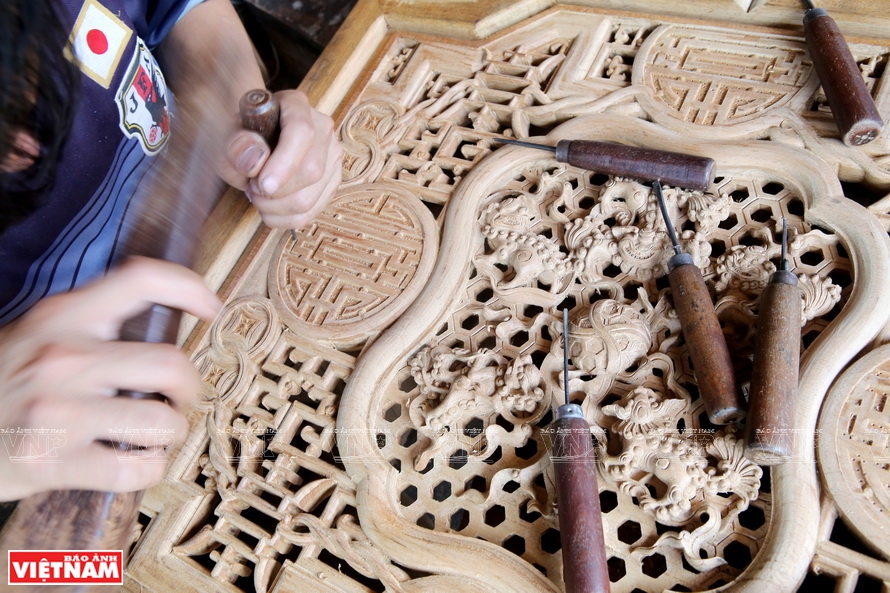 Delicate wood carving. Photo: Thanh Giang / VNP 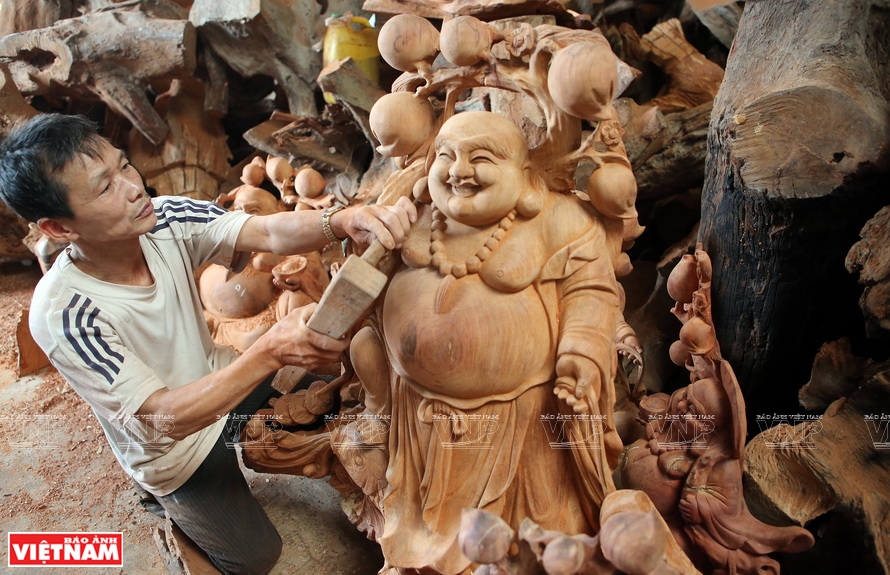 Du Du wooden sculpture village, Thanh Thuy commune, Thanh Oai district, Hanoi. Photo: Trinh Bo / VNP 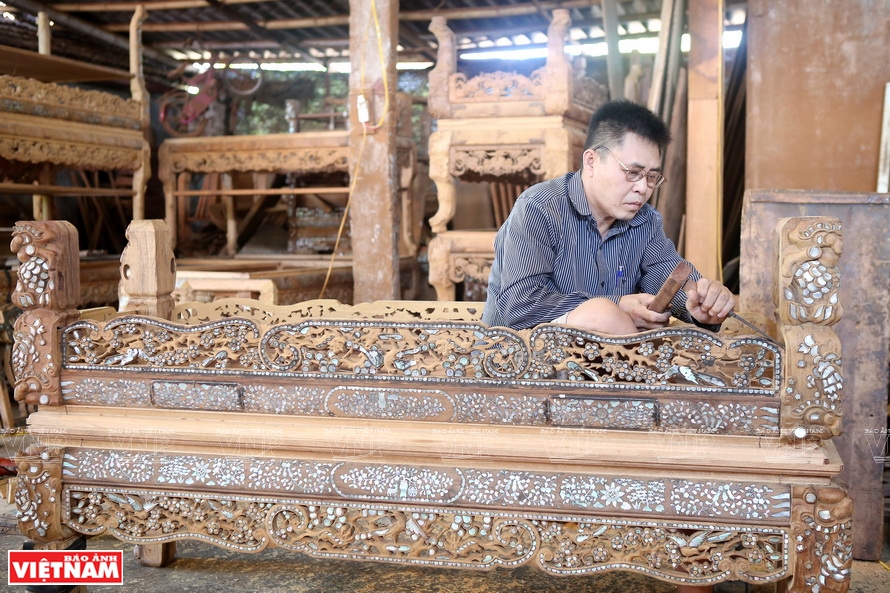 Products from Hai Minh craft village in Nam Dinh are made from high quality natural wood. photo: Thanh Giang / VNP 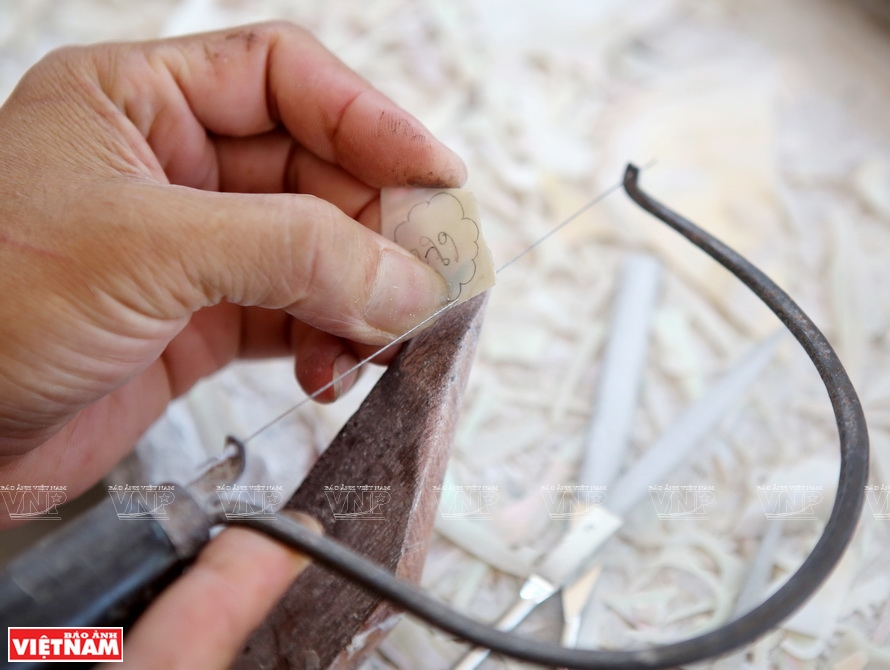 - From the shells, the Hai Minh wood craftsman creates shapes so that the material attaches to the wooden products. photo: Thanh Giang / VNP 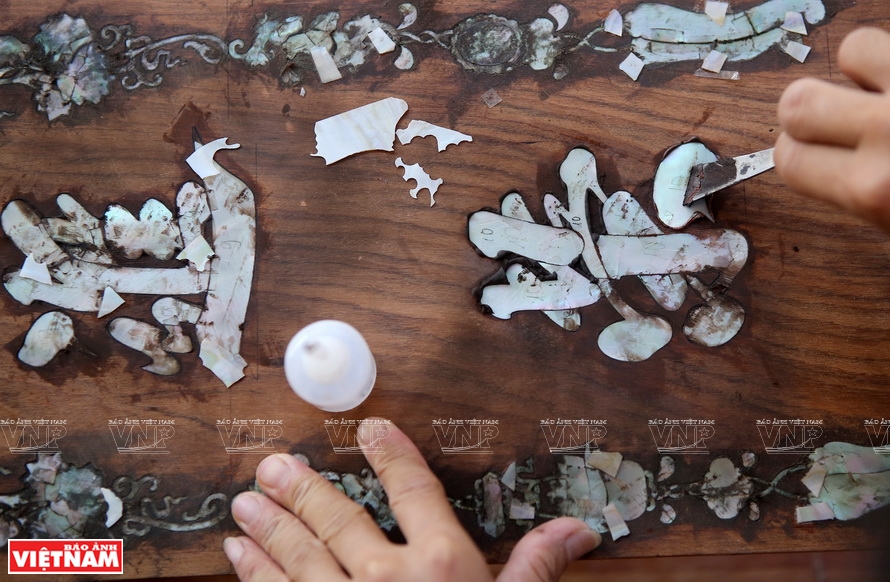 A process of completing a mosaic product in Hai Minh wood craft village. photo: Thanh Giang / VNP 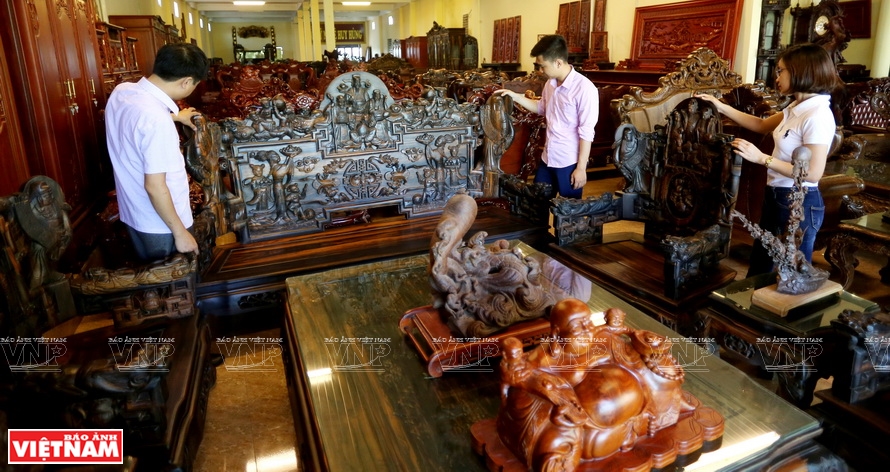 The wooden products in Hai Minh craft village are very diverse in design. photo: Thanh Giang / VNP  Wood sculptures in Thiet Ung Wood sculpture village, in Van Ha commune, Dong Anh district, Hanoi. Photo: Trinh Bo / VNP 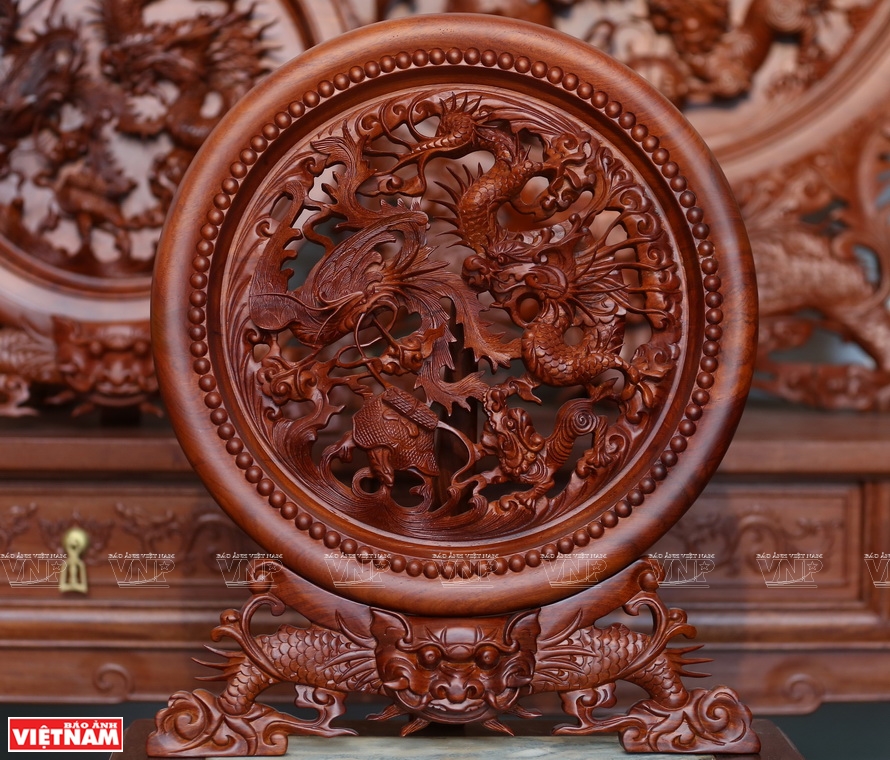 Van Ha commune, Dong Anh district, Hanoi. Photo: Khanh Long / VNP  The old house in Cu Chi, in Ho Chi Minh City was built by carpenters from Chang Son trade village in Hanoi. Photo: Nguyen Giang |
Vietnamese carpentry at that point had matured in terms of both quality and quantity. With the creativity and skill of artisans and carpenters, wood products gradually became more specialized and more trendy to meet consumers’ demands.
If La Xuyen village (Y Yen, Nam Dinh) is considered the home of the quintessence of Vietnamese woodcarving, carpentry villages in Hanoi are targeting specific segments of the market. Each village has its own unique line of products. For example, Van Diem village (Thanh Oai) is well-known for tables, desks and chairs, while Lien Ha village (Dan Phuong) is known for products such as beds, wardrobes, TV shelves, tables and chairs of all kinds. Lien Trung village (Dan Phuong) focuses on construction grade wood, and Chang Son village (Thach That) is known for building ancient wooden houses. There’s also Huu Bang village (Quoc Oai), which is known for wooden household products.
Vietnam is currently one of the four main suppliers of living room and dining room furniture to the EU, and is also the 8th largest supplier of kitchen furniture in this market. Statistics from the Ministry of Industry and Trade . |
While Hanoi carpentry villages mainly focus on modern furniture, My Xuyen village in Hue stands out for wood carvings that bear the trademark of Hue architecture, namely layered carving, intertwined carving and mosaic carving. One should also mention Kim Bong village (Quang Nam), that is known for its wooden statues.
As wooden furniture becomes more and more essential to modern life, the Vietnamese wood processing industry finds itself facing golden opportunities to step up and take the “thousand-mile” leap and furnish markets around the world.
The “thousand-mile” leap
Starting with small businesses in craft villages, Vietnamese wood processing now has big corporations with yearly export revenue reaching hundreds of millions of US dollars, contributing to the industry’s impressive growth over the past two decades.
According to statistics of the Vietnam Timber and Forest Products Association, in the past two decades, the wood processing and exporting industry has recorded breakthrough developments. In 2000, exports of wood processed products reached 219 million US dollars; by 2019 the figure had grown to 10.5 billion US dollars, and has maintained double-digit growth since.
While most of Vietnam's processing and export industries were affected by the pandemic, the wood industry continued reporting good news. Growth figures even surpassed pre-pandemic levels.
According to the General Department of Vietnam Customs, in the first 7 months of 2021, export of timber and wood products reached 9.58 billion US dollars, up 55% year-on-year; in which, wood products reached 7.44 billion US dollars, up 64%.
With the EU-Vietnam Free Trade Agreement (EVFTA) which went into effect in August 2020, Vietnam's wood industry in general and Binh Duong's wood processing and export industry in particular are expecting a watershed of orders from the European Union.
According to Dien Quang Hiep, Chairman of Binh Duong Wood Association, export markets of Binh Duong wood products are expanding strongly. In the first 8 months of 2021, the US market accounted for more than 65% of Binh Duong's total exports, up 81% over the same period in 2020. The Hong Kong (China) market accounted for 8.5%, increasing by more than 47%. The Taiwan (China) market accounted for 5.6%, up 43%.
Meanwhile, Nguyen Quoc Khanh, Chairman of the Ho Chi Minh City Handicraft and Woodworking Association, said that Vietnamese wood products had been exported to more than 120 countries and territories, but there was still room for expansion.
 Wood processing workshop at Lam Hoang Phat Company's Factory in Tam Phuoc Industrial Park, Dong Nai. Photo: VNP Production line for cutting boards and household appliances at Duc Thanh Wood Processing Joint Stock Company, in Ho Chi Minh City. Photo: Thong Hai / VNP The products of school supplies and children's toys made by Duc Thanh Wood are popular in the world market. Photo: Thong Hai / VNP |
In 2020, despite the impact of COVID-19, Duc Thanh Wood gained a revenue of 400 billion dong (17.5 million US dollars), an increase of 19% compared to 2019. As of August 2021, Duc Thanh Wood had received export orders worth approximately 16 million US dollars, completing 95% of its goal for 2021.
| Duc Thanh Wood is one of the biggest exporters of wooden kitchenware and toys in Ho Chi Minh City. In 2020, despite the impact of COVID-19, Duc Thanh Wood gained a revenue of 400 billion dong (17.5 million US dollars), an increase of 19% compared to 2019. |
Do Xuan Lap, Chairman of the Vietnam Wood and Forest Products Association, said that the wood processing industry was growing strongly in both production and export. Vietnam currently has nearly 5,000 businesses and households investing in the production and processing of wood products for export.
Over the years, Vietnamese wood processing enterprises have mostly used plantation timber. Thus, they have contributed to the protection and plantation of natural forests. Vietnam's forest coverage is now over 41%, ranking first in Southeast Asia. The development of the wood processing industry is always carried out in harmonious balance with the preservation of the ecological environment. According to a development agenda, Vietnamese wood processing enterprises are and will be applying a circular production model. That means the waste of the previous production stage will be recycled as raw material for the following stage.
 Woodsland Joint Stock Company, specializing in the production of high-class wooden furniture for export. Photo: Cong Dat / VNP Producing rubber wood for export in Binh Duong. Photo: Le Cuong / VNP Product packaging stage at Woodsland Joint Stock Company. Photo: Cong Dat / VNP 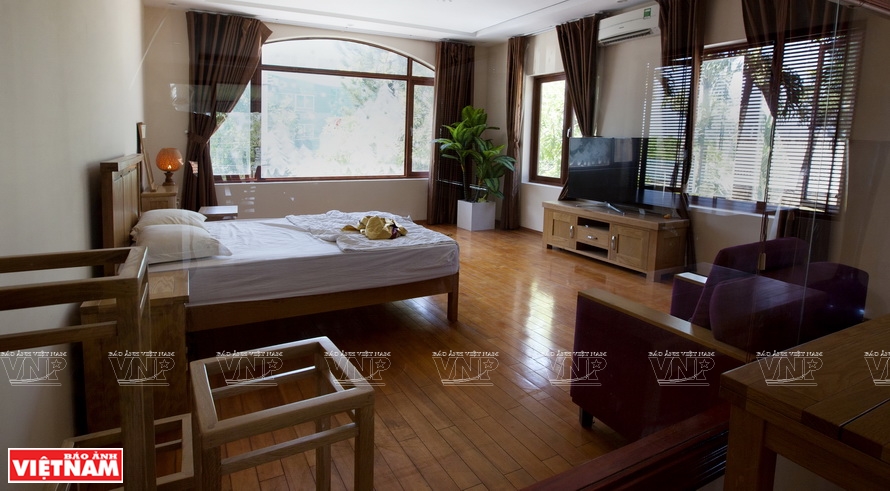 Household products of Lam Hoang Phat Oak Wood Furniture Company in Ho Chi Minh City. Photo: Kim Phuong / VNP 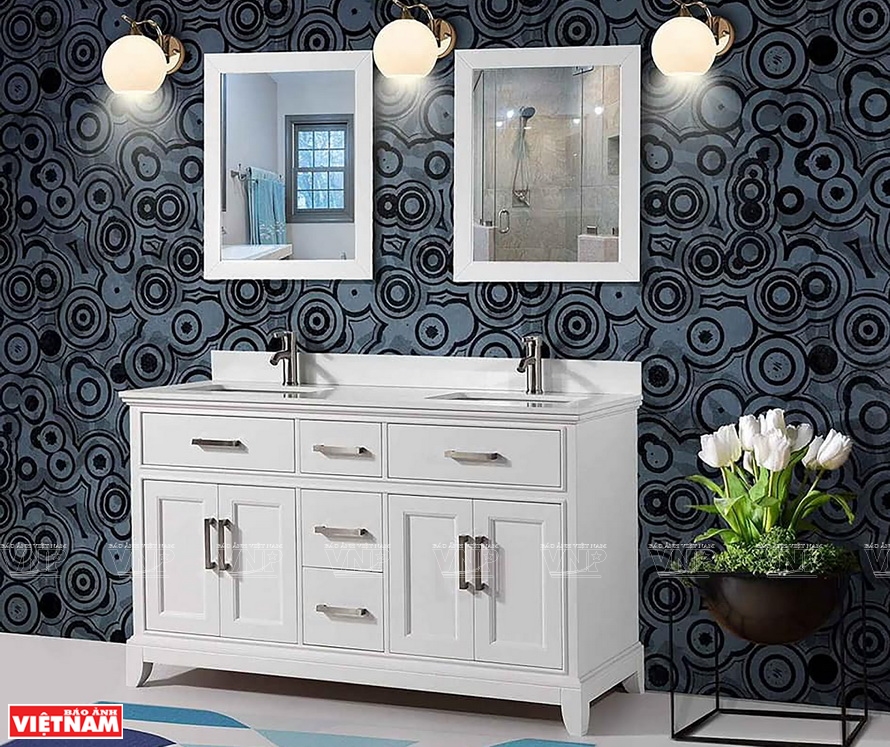 Household products of Woodsland Joint Stock Company. Photo: Cong Dat / VNP Household products of Woodsland Joint Stock Company. Photo: Cong Dat / VNP |
Despite the challenges posed by COVID-19 which is slowing down the world economy, Vietnam's wood processing industry still exceeded expectations with impressive growth figures. Accordingly, Vietnam's woodworking and furniture industry has set a target of exporting 20 billion US dollars’ worth by 2025, taking a further step toward the goal of becoming one of the world's wood processing centers.







